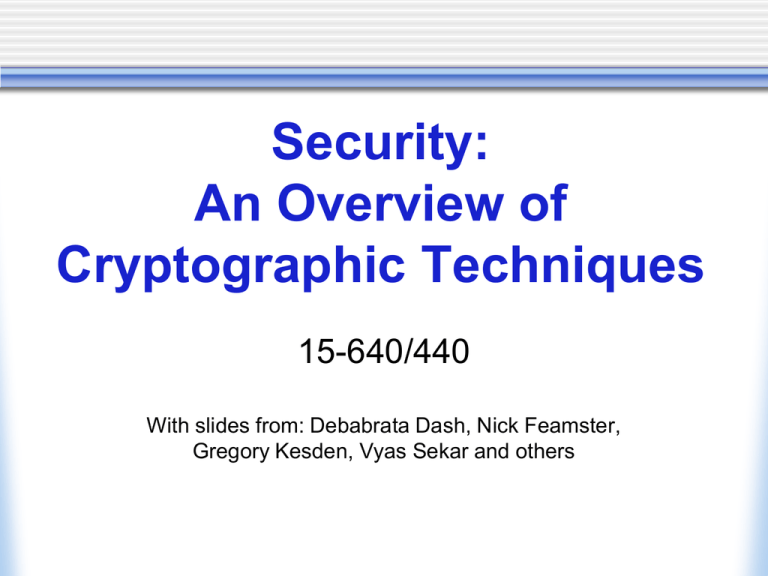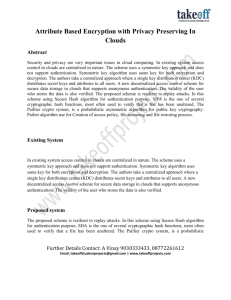ppt - Andrew.cmu.edu
advertisement

Security: An Overview of Cryptographic Techniques 15-640/440 With slides from: Debabrata Dash, Nick Feamster, Gregory Kesden, Vyas Sekar and others Cryptography, Cryptographic Protocols and Key Distribution • • • • • Authentication Mutual Authentication Private/Symmetric Keys Public Keys Key Distribution 2 What do we need for a secure communication channel? • Authentication (Who am I talking to?) • Confidentiality (Is my data hidden?) • Integrity (Has my data been modified?) • Availability (Can I reach the destination?) 3 What is cryptography? "cryptography is about communication in the presence of adversaries." - Ron Rivest “cryptography is using math and other crazy tricks to approximate magic” - Unknown TA 4 What is cryptography? Tools to help us build secure communication channels that provide: 1) Authentication 2) Integrity 3) Confidentiality 5 Cryptography As a Tool • Using cryptography securely is not simple • Designing cryptographic schemes correctly is near impossible. Today we want to give you an idea of what can be done with cryptography. Take a security course if you think you may use it in the future 6 The Great Divide Symmetric Crypto (Private key) (E.g., AES) Asymmetric Crypto (Public key) (E.g., RSA) Shared secret between parties? Yes No Speed of crypto operations Fast Slow 7 Symmetric Key: Confidentiality Motivating Example: You and a friend share a key K of L random bits, and want to secretly share message M also L bits long. Scheme: You send her the xor(M,K) and then she “decrypts” using xor(M,K) again. 1) Do you get the right message to your friend? 2) Can an adversary recover the message M? 3) Can adversary recover the key K? 8 Symmetric Key: Confidentiality • One-time Pad (OTP) is secure but usually impactical Key is as long at the message Keys cannot be reused (why?) In practice, two types of ciphers are used that require constant length keys: Stream Ciphers: Block Ciphers: Ex: RC4, A5 Ex: DES, AES, Blowfish 9 Symmetric Key: Confidentiality • Stream Ciphers (ex: RC4) Alic e: PRNG K A-B Pseudo-Random stream of L bits XOR Message of Length L bits = Encrypted Ciphertext Bob uses KA-B as PRNG seed, and XORs encrypted text to get the message back (just like OTP). 10 Symmetric Key: Confidentiality Block Ciphers (ex: AES) Block 1 Block 2 Block 3 Block 4 Round #1 Round #2 (fixed block size, e.g. 128 bits) Round #n Alice: K A-B Block 1 Block 2 Block 3 Block 4 Bob breaks the ciphertext into blocks, feeds it through decryption engine using KA-B to recover the message. 11 Cryptographic Hash Functions • Consistent hash(X) always yields same result • One-way given Y, can’t find X s.t. hash(X) = Y • Collision resistant given hash(W) = Z, can’t find X such that hash(X) = Z Message of arbitrary length Hash Fn Fixed Size Hash 12 Symmetric Key: Integrity • Hash Message Authentication Code (HMAC) Step #1: Message Alice creates MAC Hash Fn MAC K A-B Step #2 Alice Transmits Message & MAC MAC Message Step #3 Bob computes MAC with message and KA-B to verify. Why is this secure? How do properties of a hash function help us? 13 Symmetric Key: Authentication • You already know how to do this! (hint: think about how we showed integrity) I am Bob Hash Fn A43FF234 K A-B whoops! Alice receives the hash, computes a hash with KA-B , and she knows the sender is Bob 14 Symmetric Key: Authentication What if Mallory overhears the hash sent by Bob, and then “replays” it later? ISP D ISP B ISP C ISP A A43FF234 Hello, I’m Bob. Here’s the hash to “prove” it 15 Symmetric Key: Authentication • A “Nonce” A random bitstring used only once. Alice sends nonce to Bob as a “challenge”. Bob Replies with “fresh” MAC result. Nonce Bob Alice Nonce Performs same hash with KA-B and compares results B4FE64 Hash B4FE64 K A-B 16 Symmetric Key: Authentication • A “Nonce” A random bitstring used only once. Alice sends nonce to Bob as a “challenge”. Bob Replies with “fresh” MAC result. Nonce ?!?! Alice Mallory If Alice sends Mallory a nonce, she cannot compute the corresponding MAC without K A-B 17 Symmetric Key Crypto Review • Confidentiality: Stream & Block Ciphers • Integrity: HMAC • Authentication: HMAC and Nonce Questions?? Are we done? Not Really: 1) Number of keys scales as O(n2) 2) How to securely share keys in the first place? 18 Asymmetric Key Crypto: • Instead of shared keys, each person has a “key pair” KB Bob’s public key KB-1 Bob’s private key The keys are inverses, so: KB-1 (KB (m)) = m 19 Asymmetric Key Crypto: It is believed to be computationally unfeasible to derive KB-1 from KB or to find any way to get M from KB(M) other than using KB-1 . => KB can safely be made public. Note: We will not explain the computation that KB(m) entails, but rather treat these functions as black boxes with the desired properties. 20 Asymmetric Key: Confidentiality encryption algorithm ciphertext KB (m) KB Bob’s public key KB-1 Bob’s private key decryption algorithm plaintext message m = KB-1 (KB (m)) 21 Asymmetric Key: Sign & Verify If we are given a message M, and a value S such that KB(S) = M, what can we conclude? • The message must be from Bob, because it must be the case that S = KB-1(M), and only Bob has KB-1 ! This gives us two primitives: Sign (M) = KB-1(M) = Signature S Verify (S, M) = test( KB(S) == M ) 22 Asymmetric Key Review: • Confidentiality: Encrypt with Public Key of Receiver • Integrity: Sign message with private key of the sender • Authentication: Entity being authenticated signs a nonce with private key, signature is then verified with the public key But, these operations are computationally expensive* 23 Biometrics Nice in some respects No need to distribute Reducible to digital form Unique in practice Hard to duplicate? Used via binary representation Warm gelatin fingers or slip-on finger-pads molded to prints? Artificial eyeballs made to match scans? Pictures? Videos w/blinking? Change over time? Injury? Aging? Not replaceable or revocable What happens when “stolen?” Are you “Deleted”?!?!? (Well, you do have 10 fingers, two retinas, one nose, etc) 24 Multi-Factor, Human Factors Best systems use more than one factor Something you know Something piece of you Biometrics + Password/Q&A Challenge, Etc More natural factors better than fewer unnatural challenges More weak factors may be stronger than fewer stronger factors Human factors are critical Too many password restrictions? Too many passwords? Write them down on Post-Its Notes! 25 Summary – Part II • Symmetric (pre-shared key, fast) and asymmetric (key pairs, slow) primitives provide: Confidentiality Integrity Authentication • “Hybrid Encryption” leverages strengths of both. • Great complexity exists in securely acquiring keys. • Crypto is hard to get right, so use tools from others, don’t design your own (e.g. TLS). 26







